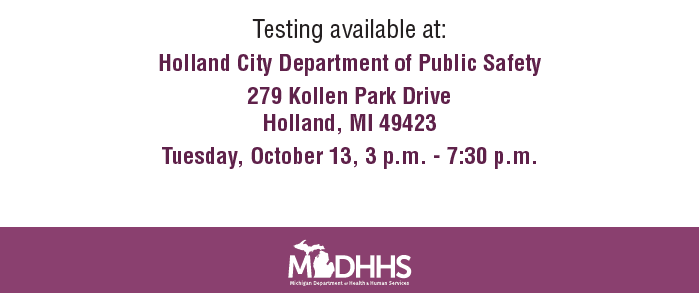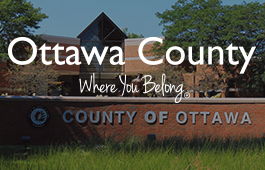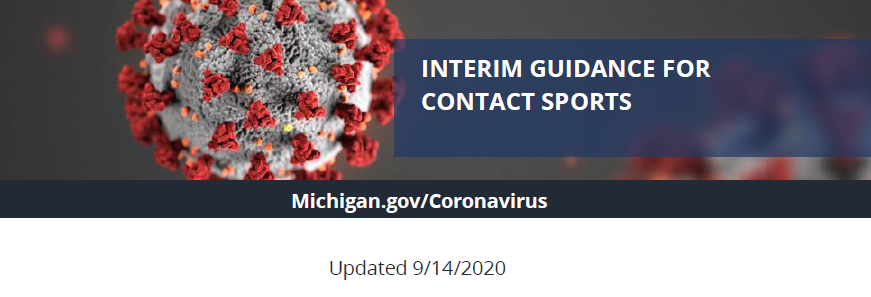Ottawa County Updates I October 6, 2020
Previous Bulletins
Media Contact: Kristina Wieghmink, public information officer
kwieghmink@miottawa.org I mobile/text 616-510-8523

Click to enlarge the dashboard view and to open other data sets.
Sources: Michigan Disease Surveillance System, Michigan Department of Health and Human Services and U.S. Census Bureau, 2018 American Community Survey 1-Year Estimates
MDHHS Emergency Order - Gathering Prohibition and Mask Order
On Friday, October 2, 2020, the Michigan Supreme Court determined Governor Whitmer did not have the authority to issue executive orders under emergency declarations past April 30, 2020. In response to the court’s ruling, Michigan Department of Health and Human Services (MDHHS) Director Robert Gordon issued an Emergency Order under the Michigan Public Health Code MCL 333.2253 restricting gathering sizes, requiring face coverings in public spaces and placing limitations on bars and other venues.
Under MCL 333.2253, if the MDHHS director determines that control of an epidemic is necessary to protect the public health, the director by emergency order may prohibit the gathering of people for any purpose and may establish procedures to be followed during the epidemic to ensure the continuation of essential public health services and enforcement of health laws.
This order—and any future MDHHS emergency orders—applies to Ottawa County and its residents. The Ottawa County Department of Public Health (OCDPH) will continue to work with County Emergency Management and County Administration to discuss together as a county leadership the course of local actions to protect the health and safety of our community.
“We work for a community that has a diversity of voices and opinions, and each perspective is important when developing health policy,” said OCDPH Deputy Health Administrator Marcia Mansaray. “Public health officials hear you. Our department is committed to protecting public health by taking action that has been shown through scientific research to prevent the spread of serious communicable diseases, like COVID-19. We work hard to balance personal rights with the important responsibility of protecting the health and safety of all Ottawa County residents.”
Risks around COVID-19 are rising; students are back in school, colder weather is moving us indoors and flu season is approaching. Scientific research has repeatedly linked mandates to reductions in COVID-19’s spread. The science is clear—wearing masks can reduce the chance of transmitting COVID-19 by about 70%. Even with masks, the transmission is likeliest when people are within 6 feet of each other for 15 minutes, especially indoors. The failure to take proper precautions can enable the disease to spread.
More information about the state health department's emergency orders is below in the State Updates section.
Other Latest Updates from Ottawa County's COVID-19 Response
10/05/20 - Statement from the Ottawa County Health Officer about the Governor's revoked emergency powers and local action
10/01/20 - Ottawa County health officials see GVSU positive COVID-19 cases trend downward - Staying Safe order to be issued
09/16/20 - Ottawa County COVID-19 case increase among young adults prompts public health officials to issue a ‘Staying in Place’ order for GVSU Allendale
More Updates
  Need More Testing Site Options?
Sites In Ottawa County | Spanish | Sites Throughout Michigan
Click to learn more.
Click to find vaccines near you.


Face coverings are REQUIRED to be worn before entering any Ottawa County building.
For more information about county services, please visit miOttawa.org.
|
 MDHHS issues Emergency Order designed to protect the health and safety of all Michiganders
Directive restricts gatherings, requires face coverings, limits bars and other venues
LANSING, Mich. – Michigan Department of Health and Human Services (MDHHS) Director Robert Gordon issued an Emergency Order under MCL 333.2253 restricting gathering sizes, requiring face coverings in public spaces and places limitations on bars and other venues. The order follows the Michigan Supreme Court decision on Friday, Oct 2, that invalidated COVID-19 related executive orders. The order relies on authorities that were first enacted after the Spanish Flu of 1918, and that were not at issue in the Michigan Supreme Court’s decision.
READ MORE
Director Gordon’s Statement – An order that can save lives from COVID-19
MDHHS Emergency Order – Gathering Prohibition and Mask Order
The MDHHS order largely reinstates, under the department’s authority, three major aspects of prior emergency orders:
Requirements to wear masks at indoor and outdoor gatherings: The order requires individuals to wear masks when in gatherings, defined as any occurrence where persons from multiple households are present in a shared space in a group of two or more and requires businesses and government offices to enforce those requirements for gatherings on their premises. The order also requires the wearing of masks at schools, except for in Michigan Economic Recovery Council Region 6.
Limitations on the size of gatherings: The order reinstates limitations on gathering sizes that mirror the requirements that Governor Whitmer had previously put in place. These include indoor gatherings of more than 10 and up to 500 people occurring at a non-residential venue are permitted within the following limits:
- In venues with fixed seating, limit attendance to 20% of normal capacity. However, gatherings up to 25% of normal capacity are permitted in Michigan Economic Recovery Council Region 6.
- In venues without fixed seating, limit attendance to 20 persons per 1,000 square feet in each occupied room. However, gatherings of up to 25 persons per 1,000 square feet are permitted in Michigan Economic Recovery Council Region 6.
- Non-residential outdoor gatherings of between 100 and 1,000 persons at venues with fixed seating are permitted at up to 30% of normal capacity and at 30 persons per 1,000 square feet at venues without fixed seating.
Limitations on certain establishments: Although the order does not close bars, it requires them to close indoor common areas where people can congregate, dance or otherwise mingle. Indoor gatherings are prohibited anywhere alcoholic beverages are sold except for table services where parties are separated from one another by at least six feet.
MDHHS Issues Emergency Orders Establishing Protections for Individuals and Staff in Residential Care, Congregate Care and Juvenile Justice Facilities
Directives cover communal dining, visitation, COVID-19 notifications
The residential care order has three major components: notice requirements regarding cases, limitations on visitations and limitations on communal dining.
With respect to notice, under the order, all covered facilities must:
- Notify employees and residents of the presence of a confirmed COVID-19 positive employee or resident within 12 hours of identification.
- Inform legal guardians or health proxies for all residents within the facility of the presence of a confirmed COVID-19 positive employee or resident within 24 hours.
- Post a notice in a conspicuous place near the main entrance of the care facility indicating the presence of a confirmed COVID-19 positive employee or resident.
- Contact the local health department in the facility’s jurisdiction to report the presence of a confirmed COVID-19 positive employee or resident.
READ MORE
MDHHS Issues Emergency Order Requiring Schools to Issue Public Notification of Probable and Confirmed COVID-19 Cases
This order requires K-12 schools to provide a public notice to the school community about probable and confirmed cases of COVID-19 within 24 hours. The order requires local health departments to notify schools within 24 hours of learning of a probable or confirmed school-associated case of COVID-19. Upon notification, schools must provide public notification on a highly visible location on the school’s website that covers the impacted building or location within 24 hours. Schools are encouraged to provide information about measures in place at the school to prevent transmission of COVID-19, as well as measures that individuals can take to prevent transmission.
READ MORE
 Michigan Department of Health and Human Services: Given the available epidemiological data and timing as many schools and universities return to campus, contact sports, such as football and wrestling, pose a high risk of transmitting COVID-19 to athletes, coaches, and the general community, and should be avoided at this time.
READ MORE
The Michigan Department of Health and Human Services (MDHHS), Michigan Association for Suicide Prevention and national and local suicide prevention organizations have been working tirelessly to halt the growth of suicide rates in Michigan.
Warning signs for those at risk of suicide include:
- Feelings of hopelessness.
- Threatening to or talking about wanting to hurt oneself.
- Loss of interest in activities.
- Withdrawal from friends and family.
- Change in eating and sleeping habits.
If you are in a crisis, or know someone who needs help, contact the National Suicide Prevention Lifeline at 800-273-TALK (8255) or visit the MDHHS Suicide Prevention website for more information.
Additional emotional-support services for those who are feeling emotional distress during the COVID-19 pandemic are available at Michigan.gov/StayWell or by calling Michigan Stay Well Counseling via the COVID-19 Hotline at 888-535-6136 and pressing “8” to talk to a counselor 24/7.
Click to watch the video.
News & Information from the State
Read all of the latest news from all state departments HERE.
Twitter.com/MichStatePolice I Facebook.com/MichiganStatePolice
Subscribe to State Updates
Governor Whitmer I Attorney General
Michigan Department of Health and Human Services
Click for the latest research.
Centers For Disease Control and Prevention (CDC) Updates
CDC Updates “How COVID is Spread” Webpage
CDC issued updated guidance to its How COVID-19 Spreads website, which includes information about the potential for airborne spread of the virus that causes COVID-19. CDC’s recommendations remain the same based on existing science and after a thorough technical review of the guidance. Scientific Brief: SARS-CoV-2 and Potential Airborne Transmission
COVID-19 Science Update
Peer Reviewed: SARS-CoV-2 seroprevalence among healthcare, first response, and public safety personnel, Detroit metropolitan area, Michigan, USA, May – June 2020. Akinbami et al. Emerging Infectious Diseases (September 21, 2020).
Key findings:
- Of 16,397 participants, 6.9% (95% CI 6.5% – 7.3%) were positive for SARS-CoV-2 IgG.
- Seroprevalence was highest (11.0%, 95% CI 10.3% – 11.7%) at facilities within 15 km of Detroit’s center and lowest (1.8%, 95% CI 1.4% – 2.2%) at locations 30 – 55 km away (Figure).
- Exposure to a household member with confirmed COVID-19 (adjusted odds ratio [aOR] 6.18, 95% CI 4.81 – 7.93) and working within 15 km of Detroit’s center (aOR 5.60, 95% CI 3.98 – 7.89) were strongly associated with seropositivity.
- Consistently using N95 respirators (aOR 0.83, 95% CI 0.72 – 0.95) or surgical facemasks (aOR 0.86, 95% CI 0.75 – 0.98) decreased the likelihood of seropositivity.
MMWR
|
|
|
|
 |
ALL NIH NEWS RELEASES
|